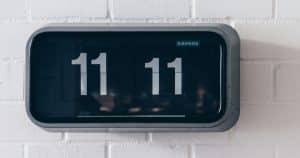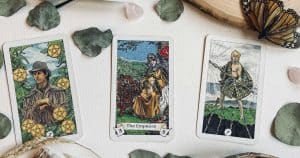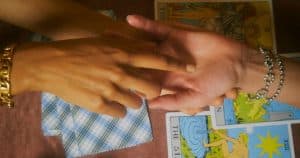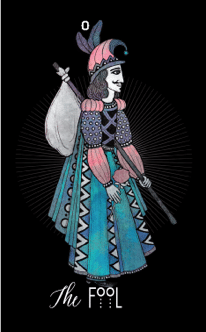Have you ever sat down to read cards for yourself, only to find that the reading didn’t really speak to you? So you do another, still not getting an answer you really want. More agitated, you do another, and this time the layout is even more mystifying. Why won’t the cards work? It’s so frustrating!
Doing multiple readings on a topic in one sitting is one of the most common mistakes that people make when reading cards for themselves. When we’re anxious about a certain issue, we often have a pretty clear answer we want to hear. Even if we don’t admit that to ourselves, the desire is there in our subconscious.
Tarot cards, or any other divination technique, won’t work if you aren’t in a clear state of mind. Of course, that doesn’t mean that we can’t read for ourselves if we have a preferred outcome to an issue, but we do need to be in a neutral, calm space if we are going to accurately read for ourselves. I tell my clients and students that the worst time to do a Tarot reading is when you most want the answer.
There are a few other common pitfalls that can affect the accuracy of your Tarot reading. Let’s check them out.
Reading When Emotional
The second biggest mistake I see people make is pulling out their deck immediately after a challenging encounter with their boss or boyfriend. They are highly emotional, and like the above multiple-reading scenario, you absolutely will not get an accurate reading when you can’t be a clear channel.
It’s common to draw the cards you are most afraid of when you are pulling cards in an anxious state, which often makes things worse. Then you might just do another reading, compounding the issue, and so it goes. Before long, you are more upset and confused about what happened and how to handle it.
This is a perfect time to get an objective reading from a friend or advisor. Or better yet, cool down, take some time, and then get a reading. You likely won’t hear another reader clearly either if you are in an emotional state.
Choosing the Wrong Spread
While there is really no wrong way to read the Tarot, certain spreads work well when reading for yourself. I typically find that a three card spread is sufficient for most complex issues. Many of my clients who read for themselves will show up with a complicated layout and want help in decoding it. Usually we end up starting over with a three card spread to work on the bigger themes of their issue. It may make sense to do a larger layout once we’ve isolated one component of a problem (I like the 10-card Inner Work spread).
More cards don’t necessarily clarify the issue at hand, especially if there are many aspects in play. When you are just learning to read for yourself, keep your layouts simple. You’ll get more accuracy in your reading and build up experience with the cards in a more digestible way.
Adding Too Many Clarifiers
Like the above mistakes, often people will get cards they don’t understand, or an outcome card they don’t like. Then they start pulling clarifying cards from the deck, and each one adds to the confusion rather than clearing up the issue. This was my downfall when I first started reading for myself, and it can become a frustrating compulsion that leads to you not trusting yourself!
To read cards accurately for yourself, you’ve got to trust your impressions–and that includes your confusion at first. When you get an outcome card you don’t like, for example, sit with that discomfort. Ask yourself why. See what is there. And then step away from the reading and let inspiration trickle in.
The same goes for cards you can’t force to “fit” an issue. Go with any insight you have, even if it doesn’t make sense. Take time away from the reading. If you are still stumped, it’s ok to draw a clarifying card, but stop at one.
Looking Up Too Many Card Meanings
My other favorite mistake, and one that’s common with beginning readers, is to search out too many meanings for a card. Usually we have a subconscious agenda when we do this, and we’re trying to find the meaning that suits that agenda best. There are many interpretations out there for each card. You may find that Crowley’s concepts are spot on, or that you prefer Pollock or Waite.
When you are learning Tarot, you do have to look up meanings, and I like Tarot dictionaries for this. But as you grow in intuition and experience, you will have your own interpretations for the cards to mix with the traditional. Let your card’s imagery speak to you. Go with your gut on what a card means in a certain position.
Reading About Others’ Feelings or Motives
This is a tricky pitfall, and one that is challenging to do with any accuracy, especially if you are invested in the outcome. I do pull cards to gain insight on the energy another is bringing to a situation, but I’m very careful in how I interpret that information.
Many clients come with relationship woes. They’ve done a spread on their own and pulled a card that scares them to represent their partner. I find that the cards we pull to represent another will often speak more to our projection onto them, rather than their own feelings or motives.
If I really want the cards to speak for another, I always get a colleague to read for me. The danger of projection and attachment aren’t there, and a neutral reading is more reliable.
Like with all the common mistakes, confusion and disappointment in spreads comes when we’re not really in a good space to read the cards for ourselves. You can always do another reading another day. Or you can get a professional reading.
Some issues we just can’t be objective about. Keen advisors are here to help you, and they can bring the objectivity to a reading when you can’t.












